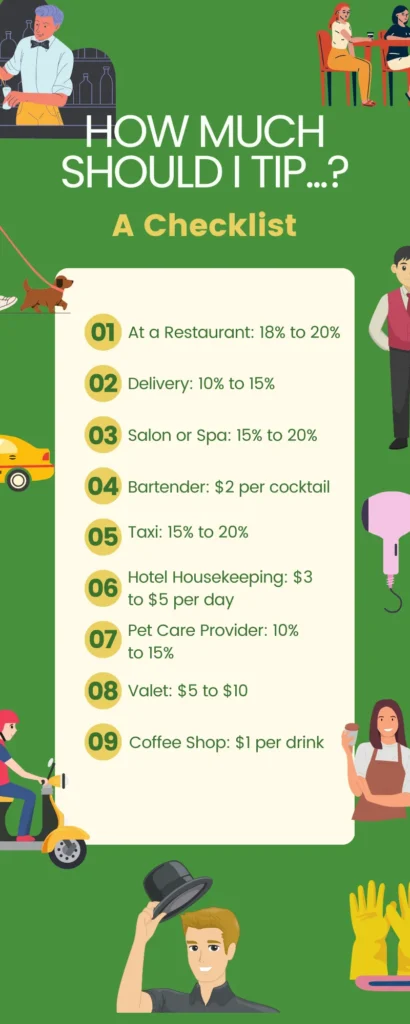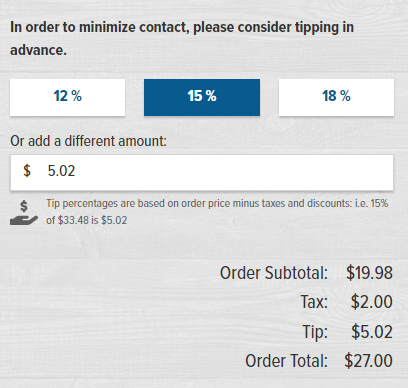Picture this: you’re out to dinner with friends, enjoying a scrumptious meal and lively conversation. The waiter brings the bill, and all eyes turn to it with a mixture of curiosity and dread. As you calculate your portion, a question lingers in the back of your mind: is 15% a generous tip? In this article, we take a hilarious dive into the world of tipping etiquette, exploring the age-old dilemma of how much we should leave for those who serve us. Get ready for a laugh-out-loud exploration of a topic that’s sure to leave you pondering your next restaurant outing.

This image is property of cdn.ramseysolutions.net.
Factors to Consider When Determining a Generous Tip
When it comes to determining a generous tip, there are several factors that we need to take into consideration. Each situation is unique, and it is important to assess these factors in order to make an appropriate and fair decision. So, what are these factors?
Quality of Service
The first factor that we need to consider is the quality of service. Did the staff go above and beyond to make our experience enjoyable? Did they anticipate our needs and provide prompt and efficient service? If so, then it may be appropriate to consider a more generous tip.
Type of Establishment
The type of establishment also plays a role in determining a generous tip. For example, at a high-end restaurant, where the prices are significantly higher, it may be expected to leave a larger tip. On the other hand, at a casual dining establishment, a lower tip percentage may be more appropriate.
Location
Location is another factor that can influence our tipping habits. In some countries, tipping is not customary or expected, while in others, it is an integral part of the service industry. It is important to be mindful of local customs and practices when determining a generous tip.
Size of the Bill
The size of the bill is another consideration. In general, as the bill increases, the percentage of the tip can decrease. However, it is important to remember that the quality of service should not be compromised based solely on the bill amount.
Level of Difficulty or Complexity
If we find ourselves in a situation where the service requires extra effort or skill, it may be appropriate to consider a more generous tip. For example, if we are dining at a restaurant with a large group, or if we have special dietary restrictions that require extra attention from the staff, a larger tip may be warranted.
Personal Financial Situation
Last, but certainly not least, our personal financial situation should also be taken into account. While it is important to be generous and appreciative of good service, it is equally important to ensure that we are not putting ourselves in a financially difficult position by leaving a tip that is beyond our means.
The Standard Tipping Percentage
Now that we have considered the various factors that can influence our tipping habits, let’s take a look at the standard tipping percentage that is commonly accepted in the service industry.
Industry Standard
The industry standard for tipping is generally around 15-20% of the total bill. This percentage has become widely accepted as a benchmark for determining a fair and generous tip. However, it is important to remember that this is just a guideline and may not be appropriate in all situations.
Common Expectations
In many countries, there are common expectations when it comes to tipping. For example, in the United States, it is customary to leave a 15-20% tip at restaurants, while in countries like Japan, tipping is not expected and can even be considered rude. It is important to be aware of these common expectations when determining a generous tip in different regions.
Factors That Influence Tipping Habits
While the standard tipping percentage provides a general guideline, there are several factors that can influence our tipping habits on an individual level. Let’s explore these factors in more detail.
Geographical Differences
One of the factors that can greatly influence tipping habits is geographical location. Different regions and countries have their own customs and expectations when it comes to tipping. For example, in some European countries, a service charge may already be added to the bill, eliminating the need for an additional tip. Understanding and respecting these cultural differences is important in determining a generous tip.
Cultural Perspectives
Cultural perspectives also play a significant role in tipping habits. In some cultures, tipping is seen as a way to show appreciation and gratitude for good service, while in others, it may not be as common or expected. Understanding and respecting these cultural perspectives can help us navigate tipping etiquette in various situations.
Personal Beliefs and Values
Our personal beliefs and values can also influence our tipping habits. Some individuals may feel strongly about supporting fair wages for service industry workers and may choose to leave a larger tip as a result. Others may have personal financial limitations that prevent them from leaving a larger tip. It is important to consider these personal beliefs and values when determining a generous tip.
Alternatives to Percentage Tipping
While percentage tipping is the most common method of showing appreciation for good service, there are alternative options that we can consider. Let’s explore some of these alternatives.
Fixed Amount Tips
Instead of basing our tip on a percentage of the bill, we can choose to leave a fixed amount tip. For example, leaving a $5 tip regardless of the bill total. This can be a good option when the bill is higher and a percentage-based tip may become unaffordable.
Service Charges
Some establishments may already include a service charge in the bill, eliminating the need for an additional tip. This is common in certain countries or for large parties. It is important to check the bill and understand whether a service charge has already been included before deciding on an additional tip.
No Tipping Policies
In recent years, some establishments have adopted a “no tipping” policy, where service charges or higher menu prices are used to ensure fair wages for employees. While this may initially seem like a disadvantage for us as customers, it can also provide a sense of relief knowing that our entire dining experience is covered without the need to calculate a tip.

This image is property of www.wikihow.com.
Pros and Cons of 15% as a Generous Tip
Now that we have explored the factors that influence tipping habits and alternatives to percentage tipping, let’s take a closer look at the pros and cons of using 15% as a benchmark for a generous tip.
Pros of 15% Tip
- It is a widely accepted standard in the service industry.
- It provides a starting point for individuals who are unsure of how much to tip.
- It allows for consistency in tipping habits across different establishments.
Cons of 15% Tip
- It may not always be appropriate for certain situations, such as exceptionally good service or high-end establishments.
- It may not take into account individual financial circumstances.
- It can perpetuate low wages for service industry workers if not adjusted for inflation and rising cost of living.
Alternative Perspectives on Generosity
While 15% is commonly accepted as a standard tipping percentage, it is important to recognize that generosity can take different forms. Let’s explore some alternative perspectives on generosity when it comes to tipping.
Higher Percentage Tips
For individuals who are financially able and wish to show extra appreciation for exceptional service, leaving a higher percentage tip can be a way to demonstrate generosity. This can be particularly meaningful in situations where the service exceeded expectations or went above and beyond.
Lower Percentage Tips
On the other hand, there may be situations where a lower percentage tip is more appropriate. For example, if the service was subpar or if the establishment already included a service charge. It is important to use our discretion and assess the situation before determining an appropriate tip.
Alternative Forms of Appreciation
Generosity doesn’t always have to be monetary. There are alternative ways to show appreciation for good service. For example, leaving a positive review online, recommending the establishment to friends and family, or expressing gratitude directly to the staff can all be meaningful forms of appreciation.

This image is property of cdn.gobankingrates.com.
The Emotional Value of Tipping
While tipping is often thought of as a financial transaction, it holds a deeper emotional value as well. Let’s explore the emotional aspects of tipping.
Recognition and Appreciation
Leaving a tip is a way to recognize and appreciate the hard work and effort that goes into providing good service. It can make the recipient feel valued and respected for their work, which can have a positive impact on their overall job satisfaction.
Building Relationships
Tipping can also help build relationships between customers and service industry workers. By leaving a generous tip, we can establish a positive connection and potentially receive better service in the future. It can be a way to foster a sense of mutual respect and trust.
Influencing Future Experiences
Finally, tipping can have an impact on future experiences. By leaving a generous tip, we can encourage the staff to continue providing excellent service and create a positive environment for both customers and employees. It can contribute to a cycle of goodwill and positivity.
Debunking Tipping Myths
Before we conclude, let’s debunk some common myths about tipping.
Myth: Tipping Guarantees Good Service
Contrary to popular belief, tipping does not guarantee good service. While it can be a motivating factor for some service industry workers, it does not excuse poor or subpar service. Tipping should be based on the quality of service provided, not as a way to manipulate or ensure a positive experience.
Myth: Tipping Only Applies to Restaurants
Tipping is not limited to restaurants. It is customary to tip in various service industries, such as hair salons, taxis, hotels, and more. Each industry may have its own expectations and guidelines, and it is important to be aware of these when determining an appropriate tip.

This image is property of i.redd.it.
The Importance of Personal Discretion
In conclusion, determining a generous tip is not an exact science. It requires us to consider various factors and use our personal discretion. While the standard tipping percentage of 15% provides a general guideline, it may not always be appropriate in every situation. It is important to be mindful of the quality of service, type of establishment, location, size of the bill, level of difficulty or complexity, and our own personal financial situation.
By considering these factors and using our best judgment, we can show appreciation and generosity in a way that is fair and reasonable for both the service industry worker and ourselves. Whether it’s leaving a higher percentage tip, a lower percentage tip, or finding alternative ways to show appreciation, the goal is always to recognize and value the hard work and effort that goes into providing good service.

